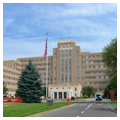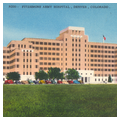The original, World War I–era hospital was built on the 595-acre Gutheil Tree Nursery after the Denver Chamber of Commerce purchased the land and leased it to the U.S. Army for $1 per year. A. H. Gutheil's home, with alterations, became the base commander's residence. Dedicated as Army Hospital No. 21 in 1918 and named for First Lieutenant William T. Fitzsimons, M.D., the first U.S. officer killed in World War I, Fitzsimons consisted of forty-eight temporary buildings that housed servicemen suffering from pulmonary-respiratory ailments caused by chemical warfare. Denver architect T. Robert Wieger of the U.S. Army Corps of Engineers helped supervise construction of the huge medical complex.
The Streamline Moderne 610-bed main building (1941) is reinforced concrete with cream-colored limestone trim and eleven varieties of buff brick used on walls,




